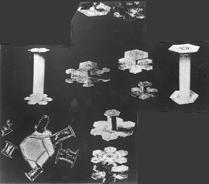 |
 |
| Home | Welcome | What's New | Site Map | Glossary | Weather Doctor Amazon Store | Book Store | Accolades | Email Us |
 | |||||||||
Weather Almanac for December 1998LET IT SNOW, LET IT SNOW
One subject everyone seems to talk about when they talk about the weather is unusual weather. When I was a kid, I remember the adults telling me that the weather -- whether heat waves, cold spells, or storms -- was worse when they were younger. Today, however, nearly everyone is commenting on the current weather events by saying that they never remember weather this bad when they were younger. But memories of events, particularly weather events are capricious at best. December is one of the better months for winter memories in North America, having moments of high suspense and violence, roaring winds and numbing cold silence, and joyous beauty. Perhaps it is the Holiday Season that heightens our collective December memories of weather events, memories of weather that spoiled or enhanced our celebrations. How often have we dreamed of a white Christmas, even if we live in Victoria, British Columbia, San Diego, California or Saint Petersburg, Florida? The month begins the first tastes of true winter weather for many North Americans as fall freezes into winter. Take a moment and think back on your weather memories from past Decembers. What sticks out in your mind the most? Unusual warmth? Extreme cold? A severe storm? Or a late December snowfall that allowed you to go skiing or sledding at Christmas? When we look at the North American continent as a whole, December is regarded as the stormiest month of the year. The Aleutian Low gives serial birth to storms which splash against the northern Pacific coast. Alberta Clippers drop down from the northern Rockies to blanket the upper Plains and Prairies with snow. Nor'easters charge up the Atlantic coast to dump rain and snow on New England and the Maritime Provinces. Winter storms in the later winter months are often more violent, but December snow storms frequently appear to have a magical quality. Often the first snows of the year fall from clouds pregnant with large, fluffy flakes that cover the fields and meadows like a goose-down duvet. When temperatures hang around the freezing point, you can almost feel an ironic warmth when surrounded by the falling flakes. Most people call almost any frozen form of precipitation other than hail or sleet a snowflake. But meteorologists are a bit more fussy. Technically the term snowflake refers to an assemblage of individual snow crystals that have collided together and remained fastened together during the fall. Snowflakes typically fall when air temperatures near the earth's surface are not far from the freezing mark. Snow crystals adhere to each other better at these temperatures. At very cold temperatures, snowflakes are uncommon and we see mostly snow crystals during a snow fall. Snow crystals are typically 0.5 to 5 millimetres ( 0.02 to 0.20 inches) in size whereas snowflakes are about 10 mm in size (0.4 inches) and may be as large as 20 to 40 mm (0.79 to 1.57 inches). The biggest snowflake reportedly measured 15 inches (38 cm) across; it fell on January 28, 1887 at Ft Keough, Montana. Snow crystals take on many forms; their structure defined by the air's temperature and moisture content and the wind turbulence in the clouds of their birth. We think of snowflakes, or more correctly snow crystals, as six-sided, frilly stars which are fairly flat, like a pizza. While this form does exist, there are a wide variety of shapes from flat hexagonal plates to three-dimensional small pillars with hexagonal plates on the ends, popularly called cufflink crystals. 
The accompanying photograph shows some of the variety of three-dimensional snow crystals. These were photographed by Wilson A. Bentley of Jericho, Vermont, who photographed thousands of snow crystals during the winters from 1880 to 1931. Nicknamed "The Snowflake Man" by his admirers, Bentley perfected the microphotography of snow crystals giving us stunning views of this miniature world. Nearly 2,500 of the best of Bentley's photographs were published in Snow Crystals, by W. A. Bentley and W. J. Humphreys by the American Meteorological Society in 1931, just before his death. (This book is still available, reprinted by Dover Books; click to order Snow Crystals by W. A. Bentley and W. J. Humphreys.) But normally in nature, such perfectly formed crystals are rare. Most crystals grow irregularly and unsymmetrically and often break off arms as they are buffeted by winds within a cloud before they grow to sufficient size to fall. And when they cling together to form a snowflake, the individual beauty is masked by the confusion of the many crystals assembled into the flake. Today, ski hill operators in many areas of eastern Canada and the United States are hoping for some natural snowfalls of considerable depth to make their ski season profitable. Young children are praying for snow so that Santa's sleigh can glide smoothly across the night on Christmas Eve. And many adults are secretly wishing for enough of the white fluff to make their area a scene from a Currier and Ives print. I too would be happy to see a white Christmas. Odds are I won't, for I live in Victoria, British Columbia where the chances are only 6 percent. But the way this year has been going, you wonder if Winnipeg and Quebec City will see a white December 25. Their probability has been 100 percent. Happy Holidays! Learn More About Snow From These Relevant Books
|
|||||||||
 |
To Purchase Notecard, |
Now Available! Order Today! | |
 |
 |
NEW! Now |
The BC Weather Book: |


